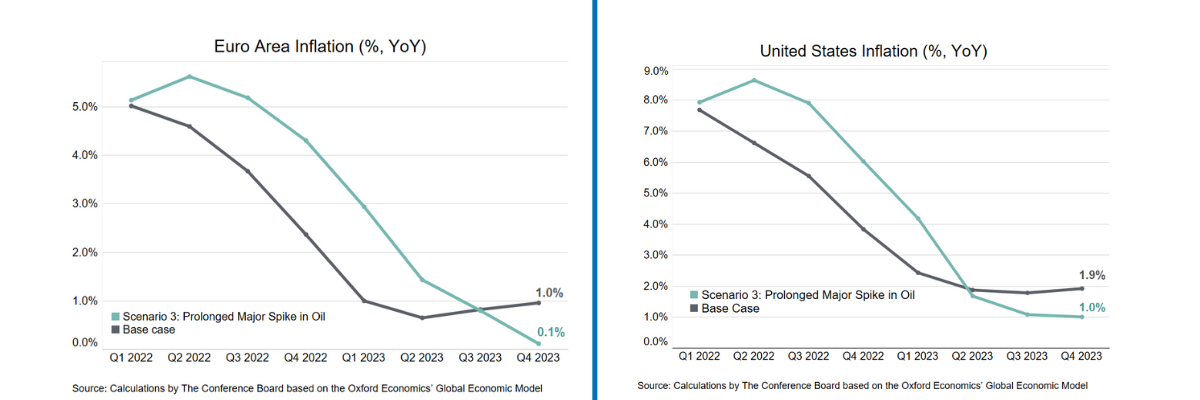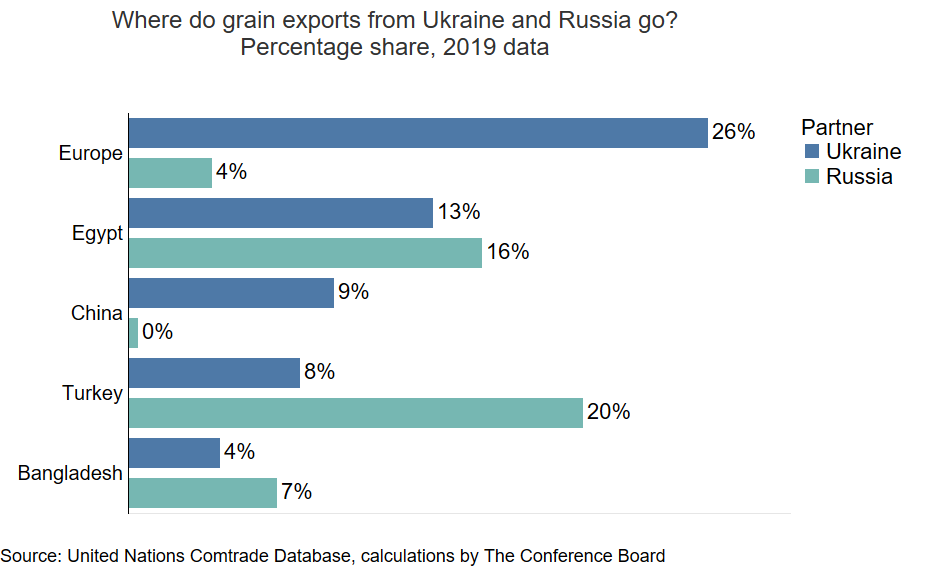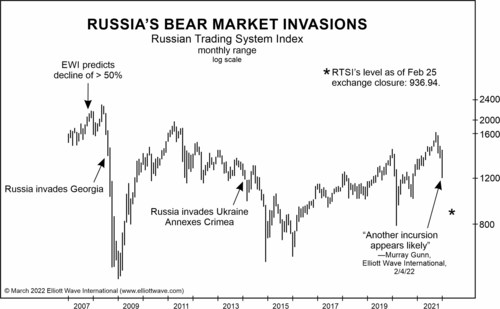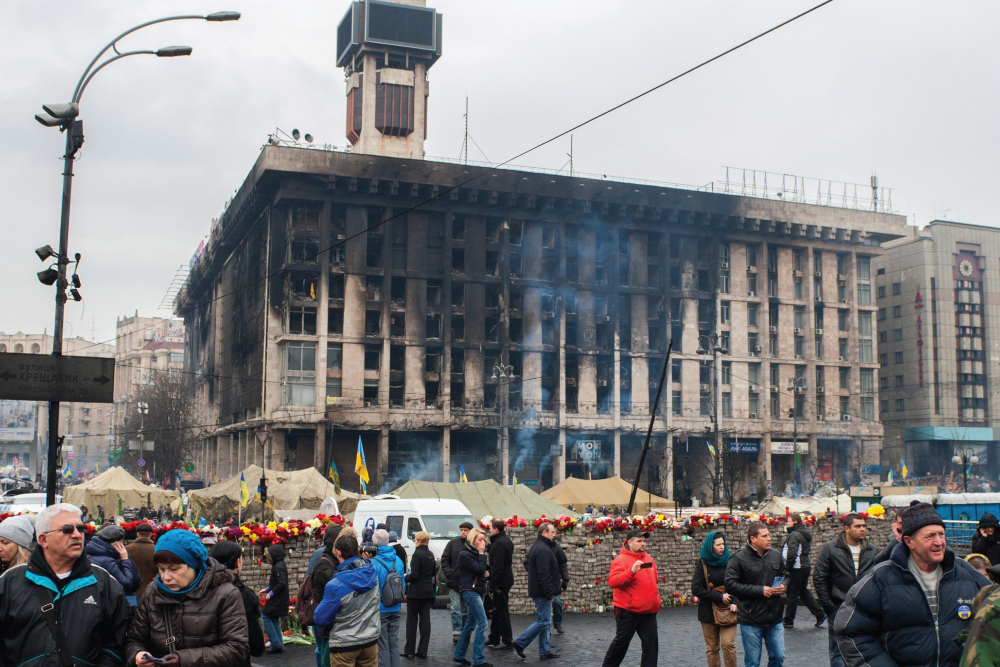Inflation expected to intensify -- Russian stock activity portended an invasion
Consensus is that Russia’s war on Ukraine will exacerbate inflation in the United States, Europe and Emerging Markets because of supply pressure from two key fronts: energy and grain. What’s more, Russian stock market activity appears to have indicated the all-out invasion was coming.
“The full invasion of Russian armed forces into Ukraine adds pressure to an already volatile energy market,” note the thought leaders at The Conference Board in a report issued in early March. “Before the escalation, the expected world oil price was in the range of $80 per barrel for 2022, but this is now likely too low, and market expectations are adjusting.”
The authors ask: What will be the impact on the economy if oil prices spike to $150?
“Growth will surely be affected even if economies around the world don’t immediately tip into recession,” they wrote. In the U.S., they surmised, year-on-year economic growth may slow to 3.0 percent in 2022 compared to a forecast of 3.5 percent. In the Euro Area, the impact could mean 3.4 percent instead of 3.8 percent forecast earlier this year.
A simulation, however, by The Conference Board based on the Oxford Economics global model shows that the inflationary impact of a major and prolonged spike of oil prices would be even more significant than the impact on economic growth. “2022 annual average inflation could reach 7.6 percent in the US, and 5.1 percent in the Euro Area, more than a percentage point above earlier forecasts for the full year,” The Conference Board analysts pointed out. Among the consequences: a further deterioration of household buying power, already under pressure from rising prices since early 2021.
“A major and prolonged spike in oil prices risks exacerbating what are already multi-decade high inflation rates and extending this period of elevated price gains even further into the future,” they concluded.

Even before the invasion, grain prices had already been trending upward worldwide as high energy costs, unfavorable weather conditions, and supply chain disruptions caused by the pandemic adversely affected global food production, noted Konstantinos Panitsas, data scientist with The Conference Board. He pointed out that grain prices increased by more than 25 percent in 2021 compared to previous year, according to World Bank data. Early 2022 data also indicated a continuation of this trend.
“Ukraine and Russia are both vital global suppliers of numerous types of cereals,” Panitsas reported. The two countries account for more than 20 percent of all cereals exported globally, according to data from the United Nations Comtrade Database. “For as long as the Russian invasion in Ukraine is in full-force, global food supply chains are likely to remain disrupted, leading to further price pressures globally,” he added.
Europe, Egypt, China, Turkey, and Bangladesh are particularly exposed as they import between 10 and 30 percent of the grain production of Russia and Ukraine, according to Panitsas. “Food inflation disrupts the purchasing power of households, especially in Emerging Markets,” he explained, adding that in Turkey, food price inflation comes on top of the double-digit inflation experienced in 2021.
“For European countries, rising food prices will add to an inflation spiral already underway with rising energy prices,” Panitsas wrote. The continent is all the more exposed as a large importer of gas and oil.
“Dampened production due to damage to infrastructure, military operations that halt harvesting, displacement of people, and port closures in Ukraine will likely worsen the mismatch between elevated global demand and subdued supply,” he maintained. “This may lead to even stronger pressure on food prices. Sanctions that target financial payments may also affect the possibility to import from Russia.”

Russian stock market warned of war: EWI
When war breaks out, financial commentators often ask, "What does the war mean for the trend of the stock market?" But no one asks ahead of time, "What does the trend of the stock market mean for the prospects of war?"
No one, that is, aside from the analysts at Elliott Wave International, who have used trends in Russia's stock market to predict the country's invasions of Georgia in 2008, Crimea in 2014 and now Ukraine in 2022.
Analysts at EWI, which is based in Gainesville, Georgia, use Robert Prechter's socionomic theory, which proposes that stock market indexes are excellent indicators of society's mood. In short, a rising stock market reflects a more positive mood, and a falling stock market reflects a more negative social mood.
"When society is in a positive mood, people send stock prices higher and prefer peace over war. When society is in a negative mood, people send stock prices lower and prefer war over peace," explained Murray Gunn, the firm's head of global research, in a press release.
Unlike stock markets in the U.S., which have mostly gone higher over the past 15 years, Russia's primary stock index, the RTSI, has gone mostly lower over that time and still trades below its 2008 high. That long-term bear market in Russian stocks has coincided with a resurgence in the country's military aggression.

Russia's three invasions over the past 15 years occurred during significant declines in the country's primary stock market index.
In late 2007, with Russia's stock market up 5,000% from its 1998 low, Elliott Wave International issued a report that forecast a major top in the RTSI and an end to Russia's amiable international relations. It pinpointed the countries Georgia and Ukraine among the most likely locales for conflict.
Six months later, the RTSI started a plunge that erased more than 50% of its value. About a third of the way into that steep drop, Russia invaded Georgia.
Fast-forward to December 2013. The RTSI was headed sharply lower again as unrest rocked Ukraine. An Elliott Wave International analyst wrote that Russia was "particularly unlikely to tolerate much more instability before intervening." Russia intervened just two months later, invading Ukraine and annexing Crimea.
Fast-forward once more to February 4, 2022. The RTSI had plummeted from its October 2021 high, and Russia had gathered troops on its border with Ukraine. Vladimir Putin claimed he had no plan to invade. But Gunn told EWI's subscribers that with the decisive move down in the RTSI, "we take those statements with a bucket-full of salt," concluding "another incursion appears likely."
And invade Russia did.
Regarding the prospects for future conflict, Gunn explained, "No matter what Russia does over the near-term, the RTSI's long-term pattern suggests that Russian aggression is extreme. Until we see a change in the bear market pattern, conflict risk will persist."
For a deeper dive on Russia, EWI's latest commentary can be found in its monthly publication, Global Market Perspective.
One point made: “As the bear market continues and Russia's economy crumbles, we can only assume that Putin will face the oncoming threats using the same methods he has used in the past: graft, coercion, intimidation and, ultimately, military force.”






